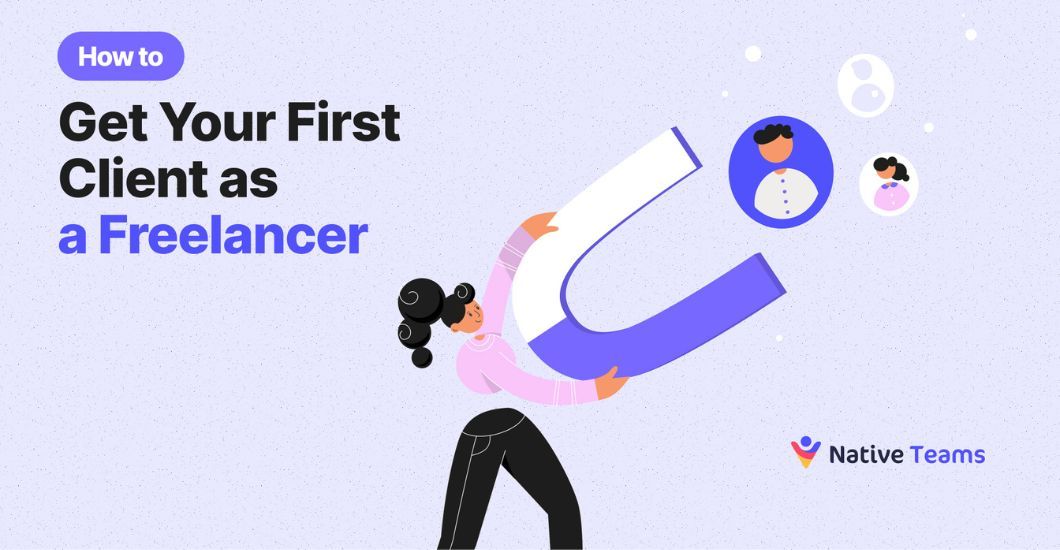How to Get Your First Client as a Freelancer in 2025? [8 Steps]
Freelancing has become one of the most popular professions in the last decade. However, as much as the promise of freedom and flexible work hours can be a dream come true, many new freelancers struggle to find their first client.
In this guide, we’ll explore the essential steps to navigate the freelance landscape and land your first client successfully. Whether you’re a writer, designer, developer, or any other type of freelancer, these strategies will set you on the right path to building a thriving freelance career. Keep reading.

Understanding the freelance landscape
The freelance landscape provides countless opportunities for individuals who want to build their careers beyond full-time employment settings. However, before you fully commit to freelancing, it’s essential to have a comprehensive grasp of the complex and dynamic landscape and prepare for the challenges that lie ahead.
The freelance landscape is diverse, extending to many industries, such as digital marketing, content writing, graphic design, development, and other popular professions.
Freelancers are essentially independent contractors responsible for sourcing their clients, managing their projects, setting their rates, and handling their tax obligations. The freedom that comes with being your own boss is a significant advantage for many, but it also comes with a whole set of responsibilities.
Finally, as much as the freelance market is extensive, it’s also very competitive. Considering that many freelancers compete for the same clients and projects, it’s important to find ways to stand out. Differentiating yourself through your skills, portfolio, and professionalism is a key to success in this dynamic market.

The current freelance market: An overview
Freelance platforms and the freelance market, in general, have witnessed growth in the past couple of years. And it’s no wonder, considering the impact of other growing trends in the gig economy and the adoption of the remote work concept.
As the digital revolution has extended to almost all industries, so has the growth in demand for a more flexible workforce and work arrangements. In other words, as businesses look for more cost-effective and specialised solutions, they often turn to the freelance market to meet their tailored needs.
The gig economy, characterised by short-term and project-based work, has also become an integral part of the freelance landscape. Many modern companies and organisations prefer hiring freelancers for specific tasks rather than maintaining full-time staff. This isn’t only beneficial for employers who strive for flexibility and cost-effective solutions, but it also opens more work opportunities for freelancers and independent contractors.
On the other hand, the growth and variety of freelance platforms and online marketplaces have become indispensable for both freelancers and clients. Such platforms provide a structured framework where freelancers and clients can connect based on relevant skills, project requirements, budgets, and other relevant factors.
Given all the advantages of independent working, the freelance market will continue growing and reshaping the general employment landscape and economy.

How to get your first client as a freelancer in 8 steps
If you’re still wondering how to get your first client as a freelancer, keep reading. In the section below, we’re giving a few strategies and tips to help you establish a successful freelance career as a newcomer in the gig economy.
1. Leveraging freelance platforms and job boards
Freelance platforms such as Upwork, Fiverr, and Freelancer are a great place to start sourcing your first clients. Such platforms’ purpose is to help freelancers connect with clients and provide a steady stream of job opportunities.
Freelancers can utilise such websites and platforms to craft personalised proposals and offer their services to different clients, which can be of great help for securing your first client.
2. Building a strong portfolio
Your portfolio serves as a business card, showcasing your skills, expertise, and the quality of services you can deliver. However, many newcomers struggle with building a portfolio due to not having many freelance projects to include.
If this is your case, it’s recommended to consider creating mock projects or offering your services at a discounted rate to start building your portfolio. Over time, your portfolio will become more comprehensive, and you can use it as a tool to attract potential clients.
To stand out further, you can also create a digital business card using a vCard QR generator. This lets potential clients scan a code and instantly access your contact details, portfolio, and social links. This makes it easier for them to reach you and remember your services.
3. Networking – the power of personal connections
Personal connections can be of great help in securing your first freelance client.
Reach out to colleagues, attend industry events, join online forums, and engage in professional networks such as Linkedin to expand your reach and promote your services and skills. Create a digital business card to easily share your contact information and make a strong, professional impression.
In an increasingly interconnected landscape, digital networking has become an essential extension of traditional relationship-building, offering freelancers the ability to connect with clients and collaborators worldwide..
Word-of-mouth recommendations and referrals are a very effective strategy that leads to securing clients in the world of the gig economy.
4. Create a professional website
Similar to a well-optimised portfolio, a professional website also serves as a hub that will showcase your work, provide information about your services, and offer a way for potential clients to get in touch with you.
When building your professional website, it’s essential to ensure it is visually appealing, easy to navigate and optimised for search engines. This way, you will improve your online visibility and the overall user experience of your potential clients.
5. Engaging on social media
Social media is the most powerful tool for self-promotion and building brand awareness.
Therefore, new freelancers can benefit from creating profiles on platforms relevant to their field of service, engaging with their audience, and connecting with potential clients. Posting relevant and quality content on social media is key to reaching a broader audience and attracting your first clients.
6. Growing beyond your first client
Once you secure your first client, it’s important to focus on delivering exceptional services. Satisfied clients are more likely to return and refer you to other potential clients.
Also, encourage your clients to provide reviews and testimonials. Not only will they help you expand your client base, but you will also build a reputation of reliability and credibility.
7. Setting long-term goals
Successful freelancers don’t just think about landing their first client, but they strategise in the long run. Therefore, it’s crucial to set clear, achievable, and long-term goals for your freelance business, such as expanding your services, reaching specific income targets, or even increasing your rates. Goals will give you a sense of direction, allow you to focus on delivering better services, and motivate you to expand your business even more.
8. Scaling your freelance business
As you gain more experience and broaden your client base, you can consider scaling your freelance business. This can include tasks outsourcing strategies, partnering with colleagues to expand your team, and even diversifying your service offerings. Scaling your business will allow you to take on more clients, increase your earnings, and achieve growth in the freelance marketplace.

Common challenges faced by new freelancers
We already established that freelancing can be beneficial for maintaining a better work-life balance and managing your own work schedule and income levels. However, this market also brings many challenges that can discourage new freelancers from continuing their journey of building an independent career. Here are some of the most common ones:
- Client acquisition and retention – Finding and securing your first client can be a daunting task, especially as newcomers don’t have a well-established reputation and struggle with huge competition.
- Establishing financial stability – Many new freelancers experience financial instability due to not having a fixed paycheck and consistent workloads.
- Managing workload – Landing more clients as a new freelancer is great, but managing workloads without the structured approach of traditional employment and working with deadlines can be stressful.
- Self-promotion – New freelancers often lack a strategy to promote their skills and services, leading to struggles with attracting new clients and expanding their online presence.
- Managing finances and taxes – Freelancers are responsible for managing their own payments, expenses, and tax obligations, which can be overwhelming without professional guidance.

To sum up
Landing your first freelance client is a significant milestone in every freelancer’s journey. While it may take some time and effort, following a few strategies will increase your chances of success. Also, remember that freelancing is not just about your first client but about building a sustainable career based on quality, consistency, and long-term work relationships.
